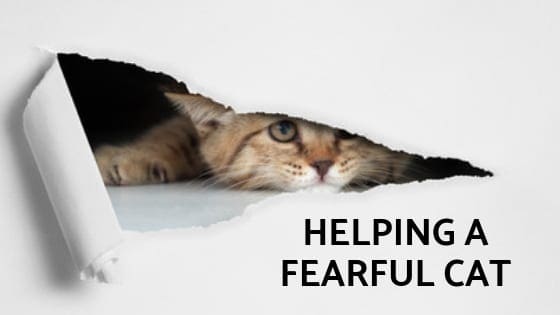
Many things can cause a cat to become fearful, such as:
Lack of socialization as a kitten
Being the target of aggression by other animals
Pain and illness
Being the target of abuse
Stressful living conditions (too many cats, dirty conditions, tense family environment, etc.)
A move to an unfamiliar environment (new home, being relinquished to shelter, being rehomed, etc.)
Change in family (new owner, death, divorce, new baby, etc.)
Excessive ongoing noise
Here are some ideas to help create more security for a fearful cat:
Hideaways
A fearful cat feels more security if she knows she can’t be seen. There should be hiding places set up for her in all the rooms where she spends time. If you want to encourage your cat to venture out from under the bed then you need to set up cozy hideaway alternatives. “A” frame beds are great hideaways because the cat can peer out but knows she won’t be ambushed from behind. High-sided donut beds and cave style are also good. Cats love being able to curl up into a tight little ball and feel the sides of the bed surrounding them.
You can create homemade hideaways with cardboard boxes. Place the box on its side and one of the flaps hang down so the opening is partially covered. Line the box with a towel or cat bed for comfort.
A cat tree is a great piece of real estate for a cat, but if the cat is fearful, she may not be secure enough being so exposed on a perch. If that’s the case, choose a cat tree that has at least one semi-enclosed perch or you can place a covered bed on one of the perches. Some fearful kitties actually like being on an open perch up high because it gives them more of a visible advantage. They have more warning time to see if someone is approaching. Being on the top perch of the cat tree also prevents the fearful cat from being ambushed from behind.
Interact at the Cat’s Pace
If you think you’ll be able to convince your cat to get over her fear by forcibly holding her in your arms or insisting she interact with family members, that method will surely backfire. All that will do is severely set back the trust-building process.
What fearful cats need is choice. They need the freedom to choose whether to be visible or hidden, whether to move closer and interact with you, or keep their distance. This is the beginning of trust-building. Cats who feel they have no choice or control in the situation feel backed in a corner and will look for the first opportunity to escape or defend themselves. Don’t underestimate the value of choice.
Offer Incentive
Keep treats on-hand and whenever the cat makes even the smallest positive step, reward her with something yummy. Clicker training works well in this type of situation. Click and reward for any behavior you’d like to see again, such as when the cat walks in the room or pokes her head out from under the bed.
If your fearful cat won’t take the treat from your hand, then gently toss it in her direction. If the treat consists of wet food, place a little on a chop stick to put a distance between you and the cat. Many times with fearful cats I’ve taped soft-tipped baby spoons to the end of a chop stick in order to give the cat a larger amount of wet food.
Playtime
Use a fishing pole toy to encourage your fearful cat to play. The pole puts a distance between you and the cat so she’ll be able to stay in her comfort zone. If the cat is more comfortable being partially hidden under the bed or behind a chair you can still offer playtime opportunities with the fishing pole. The movement you do should not be frantic or over-the-top though. A fearful cat doesn’t want to view the toy as an opponent. Make your motions low-key and easy for her to conquer the prey.
Choose your interactive toy based on your cat’s personality. If she’s extremely frightened, you may need to start with something like a feather and gradually work up to more challenging toys.
Resources
If you want your cat to feel comfortable venturing out from under the bed, create secure paths to resources such as the litter box, scratching post and feeding station. If she doesn’t feel safe then you’ll never see her during the day because she’ll only wander out to eat or use the litter box in the middle of the night when the family is asleep. Locate resources so she doesn’t have to walk across the house to reach them. You can even create little tunnels along the way so the cat remains partially hidden. You can use soft-sided fabric tunnels (available at your local pet product store and online) or you can make your own by connecting several paper bags that have the bottoms cut out. You can also use boxes or even large cardboard tubing.
Body Language
Observe and respect your fearful cat’s body language. A contributing factor to fearful behavior may be that her communication signals haven’t been respected. If her body language is saying don’t come closer and you continue to advance, then she’ll soon learn to dart away.
Environmental Enrichment
In addition to the hideaways, the cat tree and conducting interactive playtime mentioned previously, pique the cat’s curiosity and trigger her desire to play by creating a more interesting environment overall. Place puzzle feeders around and distribute interesting little toys for her to bat at for solo playtime. This will help her begin to form a positive association with the surroundings.
Need More Information?
For more information on cat behavior and training, refer to the best-selling books by Pam Johnson-Bennett. Pam’s books are available at bookstores and online. We’ve included Amazon links here on our website.




